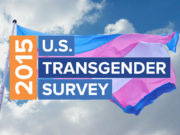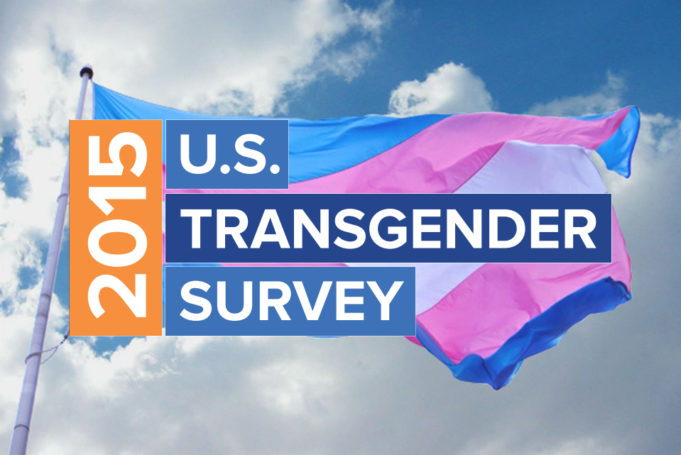The National Center for Transgender Equality released the results of the largest survey ever taken of transgender people in the United States on Thursday.
The survey featured 27,715 respondents from 2015, estimated to be about 2% of the adult transgender population. Until now, researchers were forced to rely on data released in 2011 from the National Transgender Discrimination Survey, which was based on surveys from 2008 and 2009. The new survey reveals transgender and gender non-conforming people in the U.S. are experiencing psychological distress, discrimination, physical abuse and harassment at astounding rates compared to the rest of the population.
The study found 40% of transgender people have attempted suicide in their lifetime compared to 4.6% of the rest of the population, with 48% thinking about suicide in the past year. 7% have attempted suicide in the last year compared to 0.6% for the rest of the population.

46% of the respondents have experienced verbal harassment while 14% reported being denied equal treatment. 10% reported being sexually assaulted and 9% were physically attacked.

The study has shown 30% of respondents have experienced homelessness at some point in their lives, with 29% currently living in poverty. Discrimination in housing was experienced by 23% of the respondents. 13% have lost employment because of being transgender, with 15% being either verbally, physically, or sexually assaulted in the workplace.

Over a quarter of the respondents have an immediate family member who has stopped speaking with them or ended their relationship. 14% were sent to a professional who tried to stop them from being transgender. 10% have experienced violence perpetrated by a family member. 10% ran away from their homes while 8% were kicked out.

Almost 60% of the respondents avoided using a restroom in the past year. 32% limited their intake of food and drink to avoid using the restroom. 24% had their presence questioned while using the restroom while 12% were verbally harassed. 9% reported being denied restroom access in the past year because they were transgender.

The findings have revealed disturbing patterns of mistreatment and discrimination and startling disparities between transgender people in the survey and the U.S. population when it comes to the most basic elements of life, such as finding a job, having a place to live, accessing medical care, and enjoying the support of family and community. Survey respondents also experienced harassment and violence at alarmingly high rates.
Family Support
A majority of respondents (60%) who were out to the immediate family they grew up with said that their family was generally supportive of their transgender identity, while 18% said that their family was unsupportive, and 22% said that their family was neither supportive nor unsupportive.
Religion
Nineteen percent (19%) of respondents who had ever been part of a spiritual or religious community left due to rejection.
Identity Documents
Only 11% of respondents reported that all of their IDs had the name and gender they preferred, while more than two-thirds (68%) reported that none of their IDs had the name and gender they preferred.
Health Insurance
One in four (25%) respondents experienced a problem in the past year with their insurance related to being transgender. More than half (55%) of those who sought coverage for transition-related surgery in the past year were denied, and 25% of those who sought coverage for hormones in the past year were denied. One-third (33%) of those who saw a health care provider in the past year reported having at least one negative experience related to being transgender.
HIV
Respondents were living with HIV (1.4%) at nearly five times the rate in the U.S. population (0.3%). HIV rates were higher among transgender women (3.4%), especially transgender women of color. Nearly one in five (19%) Black transgender women were living with HIV, and American Indian (4.6%) and Latina (4.4%) women also reported higher rates.
Schools (K-12)
More than three-quarters (77%) of those who were out or perceived as transgender at some point between Kindergarten and Grade 12 (K–12) experienced some form of mistreatment, such as being verbally harassed, prohibited from dressing according to their gender identity, disciplined more harshly, or physically or sexually assaulted because people thought they were transgender. Fifty-four percent (54%) of those who were out or perceived as transgender in K–12were verbally harassed, nearly one-quarter (24%) were physically attacked, and 13% were sexually assaulted in K–12 because of being transgender.
Police
Respondents experienced high levels of mistreatment and harassment by police. In the past year, of respondents who interacted with police or law enforcement officers who thought or knew they were transgender, more than half (58%) experienced some form of mistreatment. This included being verbally harassed, repeatedly referred to as the wrong gender, physically assaulted, or sexually assaulted, including being forced by officers to engage in sexual activity to avoid arrest.

Thanks to the National Center for Transgender Equality, we now have valuable data that will help activists, advocates, educators, and community organizations everywhere. Though we have pointed out some of the most glaring results, there is much more data available in the full report, which you can read on their website.
































